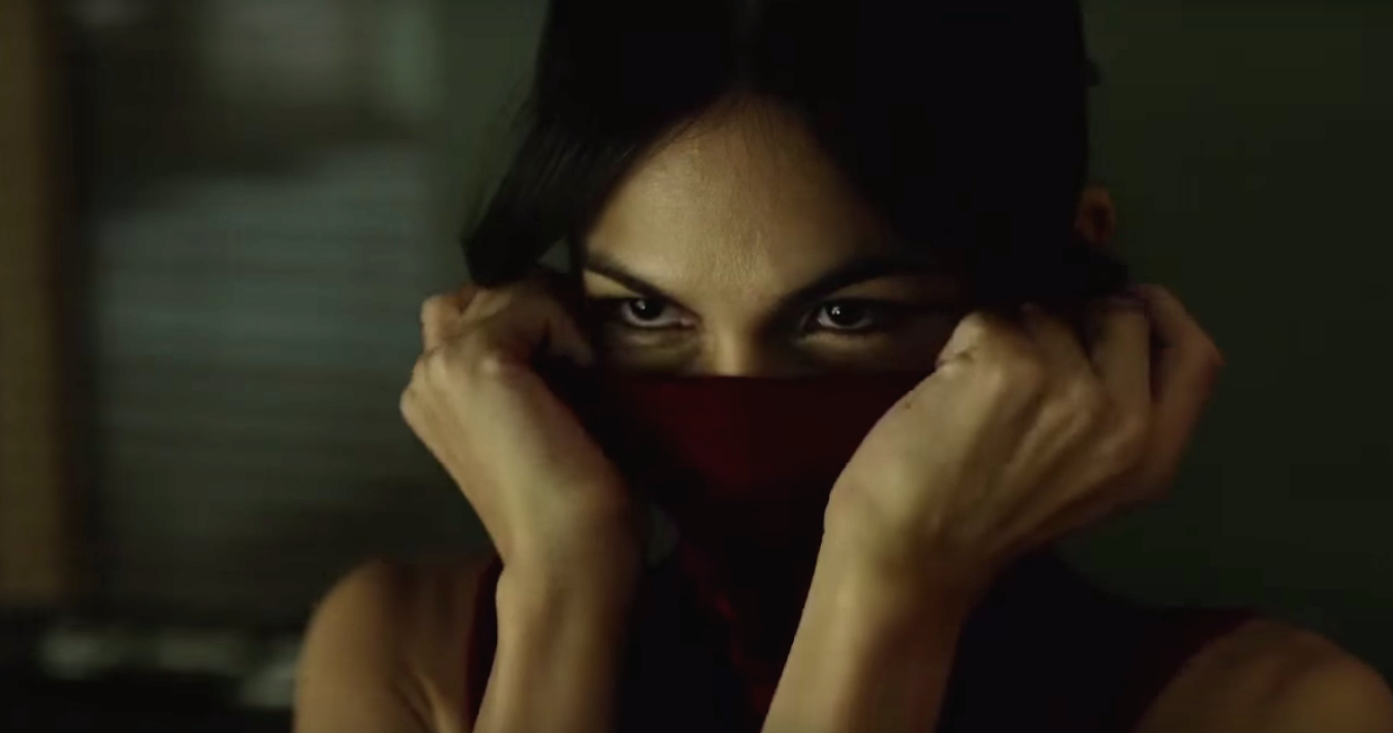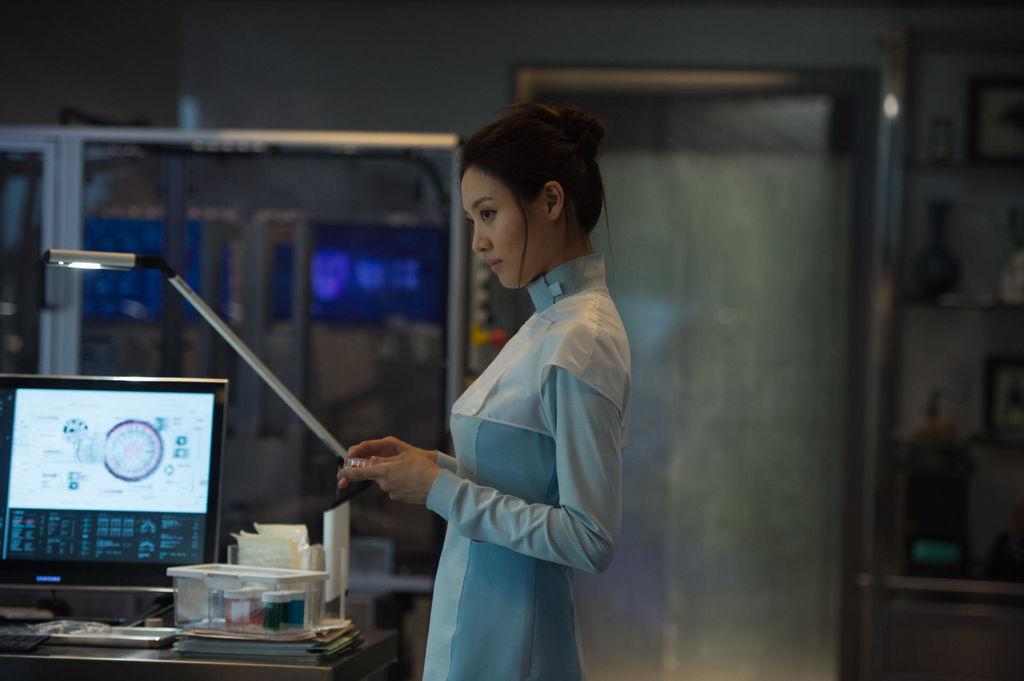This guest post written by Sophie Hall appears as part of our theme week on Unpopular Opinions. | Spoilers ahead.
When Daredevil’s first season debuted in the spring of 2015, comic book fans were basking in a nerdy afterglow. Not only were they given Marvel Studios’ first piece of R-rated entertainment, fans and casual viewers alike were captivated by Vincent D’Onofrio’s portrayal of Kingpin, now considered to be Marvel’s greatest villain since Loki.
The hype train for Daredevil gained even more passengers when the fan favorite character Frank Castle aka The Punisher was confirmed to appear in the show’s second season. Expectations were met; actor Jon Bernthal’s portrayal was loved so much that he now has his own spin-off set for 2017.
The character that I feel fans forgot to love though? Elektra Natchios.
Elektra makes her first appearance at the end of episode four in season two. Since purring her first line, “Hello, Matthew,” audience reactions have been divisive on the character. Some found her a breath of fresh air in this mainly white male-dominated show; some found Elektra’s plot problematic, particularly the series’ depiction of race, women of color, and Asian stereotypes; others found her a reduction of The Punisher’s screen time, responsible for a storyline that many viewers found muddling and worse, un-noteworthy. Not only do I strongly disagree with the latter, I believe that she is needed not only in the show, but also in the Marvel Cinematic Universe in general.
Elektra exists within a show titled Daredevil, so a lot of her story is unfortunately tied to his and we are meant to perceive her the way stringent Matthew Murdock, the titular character, does. Elektra and Matthew are old flames and after the end of their relationship ten years prior (when Elektra’s idea of a fun date turned out to be Matthew’s from hell), the pair reunite to take down the Yakuza in Hell’s Kitchen. Matthew says that if they team up, Elektra must abide by his no killing rule. She reluctantly agrees. A few episodes later, she of course breaks it (unfortunately for a teenage ninja) and the pair call it quits again. However, Elektra isn’t the one who has to ultimately transform for Matthew; Matthew ultimately has to accept Elektra. Most importantly, this implies the audience is meant to accept her too.
In a world where female characters in television are hated for minor flaws (compared to that of their spouses, anyways), I think it’s fantastic that Daredevil asks us to root for this woman whose flaws are on par with many other male anti-heroes.
In one of my favorite scenes, Elektra is leaving New York after her second breakup with Matthew with a new booty call in tow (until he tries to assassinate her). Not only does she then win a fight to the death, she wins her signature weapons (sai), and wastes no time in tracking down the man who placed the hit on her. This moment is reminiscent of practically any male lead in any superhero movie ever, yet is happening to an Asian woman instead. It shows us that her story doesn’t end after hers and Matthew’s does, it merely evolves.
Similarly to anti-heroes, Elektra’s sexuality is treated with respect. In her flashback with Matthew, she is shown to be dominant and a tad kinky in the bedroom. Coincidentally, after Elektra returns into Matthew’s life, he’s just started a rather quixotic relationship with the sweet-natured, sexually tamer Karen Page. Elektra’s sexuality could easily have been used as a way to slut shame her or mark her as inferior, yet she remains unscathed. The problems that Elektra faces are many but her sex life is not one of them. There easily could have been a scene where Elektra uses her sexuality to turn Matthew away from Karen but their most intimate moments this season involve hand-holding and touching each other’s scars (whatever floats their boats).
This leads to another thing I love about Elektra’s character: her motivations are not influenced by and do not rely on a history of sexual violence. The topic is even part of her comic book lore, yet the TV series still chose to omit it. As noted by pop culture critic Anita Sarkeesian at Feminist Frequency when she reviewed Jessica Jones:
“Just like Veronica Mars and many other “strong female characters,” Jessica Jones’ rough edges, the aspects of her character that fuel her internal conflicts and make her tough, badass, and emotionally wary, originate in her history as a survivor of rape and psychological abuse. Of course, we need stories about survivors, models of women (and men) who do the heroic work of putting one foot in front of the other and trying to heal after suffering traumatic experiences. But too often, a history of abuse is used as part of a female hero’s origin story, part of what gives them their strength.”
Elektra Natchios’ story runs parallel with The Punisher’s plotline. If audiences don’t question the fact that he doesn’t have sexual trauma to motivate his story, why should they question hers?
Furthermore, Elektra’s anti-heroine status adds more diversity to the female characters of Marvel. You wouldn’t place her in the same ranks as ‘Black’ Mariah Dillard and Whitney Frost, but she’s not up to the heroics of Natasha Romanoff/Black Widow, Misty Knight, or Agent Carter either. Elektra may kill for kicks in one scene, but in the next she contemplates suicide after discovering that she is the lethal weapon the Black Sky to protect innocent lives lost. She’s flawed, seriously so, but deep down, she ultimately strives towards the greater good.
However, this complexity isn’t solely attributed to the showrunners and writers but also to the actress playing Elektra, Elodie Yung. In a promotional interview for the show’s second season, Yung states that:
“The writers told me that they see her as a sociopath… I didn’t want to reduce her to a sociopath because I don’t think she is. I tried to combine the sociopath that they wanted with her essence from the comics and a bit of myself in her to try and get her a bit more human.’”
This is yet another example why women and people of color need to tell their own stories. If Yung hadn’t fought for and included more layers to Elektra, she could very well have been a one-dimensional villain, a negative to female characters of color rather than a positive.
https://www.youtube.com/watch?v=3g9CjhcNEWk
In some ways I found Elektra Natchios’ character more of an accomplishment than The Punisher’s, as I feel she breaks stereotypes while he conforms to them. The Punisher is a hyper-masculine, ex-military soldier on a bloody rampage for those responsible for the death of his family. His daughter seems to be at the center of his grief though, as he divulges the most about her when he breaks down to Daredevil in his graveyard monologue; his “penny and dime” catch phrase is a line from her favorite book. The Punisher’s emotional core relies on the common trope of fridging, using a woman’s death to fuel a male character’s motivation, whereas I feel Elektra breaks free of any tropes thrown her way.
I feel like I’m in the minority who feel this way though (hence this “unpopular” think piece). Thousands view Elektra’s scenes on YouTube, whereas hundreds of thousands view The Punisher’s scenes. Critic Bob Chipman at Screen Rant, wrote an article titled “How Marvel’s Daredevil Got Elektra Wrong.” He states:
“Miller/Marvel’s Elektra’s life may be a long list of unfortunate decisions, but at least they’re hers – born of her own agency and comprising her own identity. In fact, that’s the core of the tragedy on Daredevil’s end: His tortured, self-flagellating moral code can’t rationalize away the evil things Elektra does because there’s nothing external to blame. She is what she is because she’s chosen to be so. As reimagined for Netflix, just about all of that is gone.”
Although his points are reasonable and well explained, I have to disagree. Yes, Elektra from the Netflix series has many things placed upon her instead of her seeking them, but it’s how she reacts to those things that I find the most intriguing. If she were to follow Miller’s comics storyline faithfully, her death would occur to propel Matthew’s storyline. However, in the show, she dies because she chooses to die for something. When she is dying in Matthew’s arms, her dialogue isn’t, “I died for you, Matthew,” or some other tripe, instead she says, “I now know what it feels to be good.” The attention remains on Elektra.
Her choice wasn’t all for naught either. Yes, she was resurrected, so her decision to sacrifice herself was taken away. But the reason she died was to save Matthew’s life; that wasn’t taken away. For once, a female character can have her cake and eat it too: she gets what she wants, which is to save Matthew’s life, yet she doesn’t have to suffer the long-term consequences for it.
Granted, Chipman is correct in that the last two episodes prove the most troubling for her agency. After it is revealed that Elektra is the Black Sky, the men around her see her as an object to be controlled. Stick, the man who raised Elektra for most of her childhood, throws out lines like, “I tried to housebreak her,” and tries to have her killed when she breaks their alliance. Villain Nobu calls Elektra “it” and says that she “belongs” to The Hand. However, I feel credit is due to how she reacts to this objectification. In her final conversation with Stick, she tells him to stick it that “this is my life” and ignores his advice. She snarls at Nobu, “Call me ‘it’ again and I’ll cut you in half.” When Nobu states that she belongs to The Hand, she fights Nobu and The Hand. No matter what situation is placed upon her, her voice will always be heard.
Even though Elektra’s thrill for killing could be the cause of her being the Black Sky, it hasn’t been confirmed and more importantly, shouldn’t be. Elektra states that they could just want to lock her away “and do terrible things in my name,” using her as an excuse for The Hand’s actions rather than a literal weapon. We need more flawed women, female characters who have committed terrible acts but aren’t necessarily terrible people. Also, we have an abundance male characters that unnecessarily kill and their motives are rarely critiqued. As dire as it sounds, killing on-screen shouldn’t be a boys club. If it’s solely Elektra’s murderous nature that causes audience indifference to her character, why are so many male anti-heroes beloved for the exact same thing? Han Solo kills his enemies without a second thought and fans love him for it. In the “who shot first argument,” what are the fans most overwhelming answer? Han Solo is getting a prequel trilogy on his youth. Daryl Dixon from The Walking Dead used racist language and called a grieving mother a “stupid bitch” (more than once) yet his character is a fan favorite.
As Elektra is confirmed as a series regular for The Defenders, the Avengers-esque team up with more blood, sex, and cursing featuring Daredevil, Jessica Jones, Luke Cage, and Iron Fist, we should all be excited to see how her character evolves. Daredevil season two was an exciting set up for one of the most underrated characters to be introduced to the MCU. Everyone should be excited too. In the words of Matt Murdock, “What if this isn’t the end? What if it’s just the beginning?”
See also at Bitch Flicks:
Elektra in Daredevil: Violence, White Masculinity, and Asian Stereotypes
Daredevil’s Elektra and the Problem of Destiny
Daredevil and His Damsels in Distress
Sophie Hall is from London. She is a barista trying to perfect her latte art by day and perfect her writing by night. You can follow her on Twitter @sophiesuzhall.





























